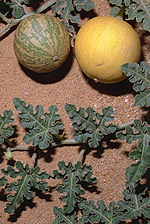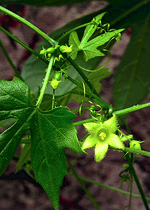 |
This is a moderate-sized family characteristic of humid to dry tropical areas especially of Africa and the Americas. The family in Australia is principally tropical, where its members are found in rain forests, coastal dunes and savannahs. Some genera extend into arid Australia, especially in gorges and ranges where there is a moist microclimate. A few introduced species are common roadside and paddock weeds, and these extend into dry temperate regions.
Characteristic features of the family Cucurbitaceae in Australia include: - robust climbing or sprawling, often rough-haired annuals or perenials, usually with coiled axillary or leaf-opposed tendrils
- leaves usually palmately lobed or veined
- flowers mostly unisexual, usually white or yellow, with more or less fused petals
- anthers often fused in some fashion, sometimes into a column
- ovary inferior; fruits usually berries, sometimes large and with a hard rind, with many seeds.
Description
Evergreen, deciduous or semi-deciduous, basally woody vines, or annual, biennial or perennial herbaceous vines, climbing by tendrils. Tendrils either opposite leaves or axillary. Perennating by taproots. Stems unarmed or rarely with prickles or spines arising from the stem surface; nodes conspicuously swollen or not; internodes solid or spongy or pithy. Internal secretions not obvious. Plants glabrous or with simple, clavate, capitate or vesicular glandular or non-glandular, unicellular or uniseriate hairs. Leaves alternate and spiral, cauline if herbs, petiolate. Stipules absent; stipellae absent. Lamina simple or once compound, ternate, symmetric or conspicuously asymmetric, pinnatifid or pinnatisect, palmatifid or palmatisect or bipinnatifid, tripinnatifid, etc; lamina/leaflets lanceolate, ovate, elliptic, oblanceolate, ovate, oblong or orbicular; base cuneate, rounded, cordate, hastate or sagittate or oblique; margins entire, crenate, dentate, serrate or sinuate, ±flat; venation pinnate, or palmate, with the midrib conspicuous, and the tertiary venation not reticulate; surfaces not punctate; herbaceous or leathery; distinctive odour absent or foetid. Male and female flowers occurring on the same plant or on separate plants. Inflorescences axillary, consisting of racemes, panicles or solitary flowers. Bracts present or absent. Bracteoles present. Pollination by insects. Flowers odourless, fragrant or malodorous; stalked. Floral disc present or absent; nectaries absent or present on the disc. Free hypanthium present or apparently absent. Perianth regular, of 2 dissimilar whorls, valvate in bud. Calyx segments free, with 5 sepals, herbaceous. Corolla segments free or fused, with 5 petals or lobes, alternating with the sepals; corolla wheel-shaped, cup-shaped or bell-shaped, white, cream, yellow, orange or green, without contrasting markings, membranous; claws absent. Fertile stamens 3 or 5, opposite to the sepals, free of the corolla, free of the ovary and style, distinct from each other, grouped or fused into bundles, fused by their filaments into an open or closed tube or fused by their anthers, all ±equal. Anthers dorsifixed or basifixed, not versatile, opening inwards by longitudinal slits, 1–2-celled, with apical appendages. Ovary inferior. Carpels 1–3, fused; ovary with 1 or 3 locules. Style terminal, single and unbranched, or branched above or from the base. Ovules 1–numerous per locule, sessile; placentation parietal. Fruit dry or fleshy, dehiscent or indehiscent; a capsule with irregular, operculate or valvular dehiscence, sometimes explosive, or a utricle, berry, drupe or pepo; the perianth on the maturing fruit deciduous. Disseminule macro-surface featureless, or winged or with spines; micro-surface ±smooth, spinulose, tuberculate, papillate, ruminate, granulate or verrucose, white, cream, brown, grey or black, without contrasting markings, or conspicuously patterned, glossy or dull. Seeds 1–numerous per fruit. Aril present or absent. Cotyledons 2. Embryo straight or curved.
(Note: this description has been generated from the coded data compiled for the key. Any errors in the key data will be reflected in the descriptions.)
A treatment of the family Cucurbitaceae has been published in:
Flora of Australia 8: 158-198.
Australian genera of Cucurbitaceae (as recognised for the Flora of Australia)
* = all species introduced
Benincasa
*Citrullus
Coccinia
*Cucumis
*Cucurbita
Diplocyclos
*Ecballium
*Lagenaria
Luffa
Momordica
Muellerargia
Mukia
Neoalsomitra
*Sechium
Sicyos
Trichosanthes
Zehneria

|
  |

Citrullus colocynthis (fruits)
Photo: D.Albrecht © Parks & Wildlife Commission of NT

Diplocyclos palmatus (flowers)
Photo: M.Fagg © M.Fagg

Diplocyclos palmatus (fruits)
Photo: H.Nicholson © H. & N. Nicholson

Luffa aegyptiaca (flowers and fruit)
Photo: J.Wrigley © ANBG

|
 |
|